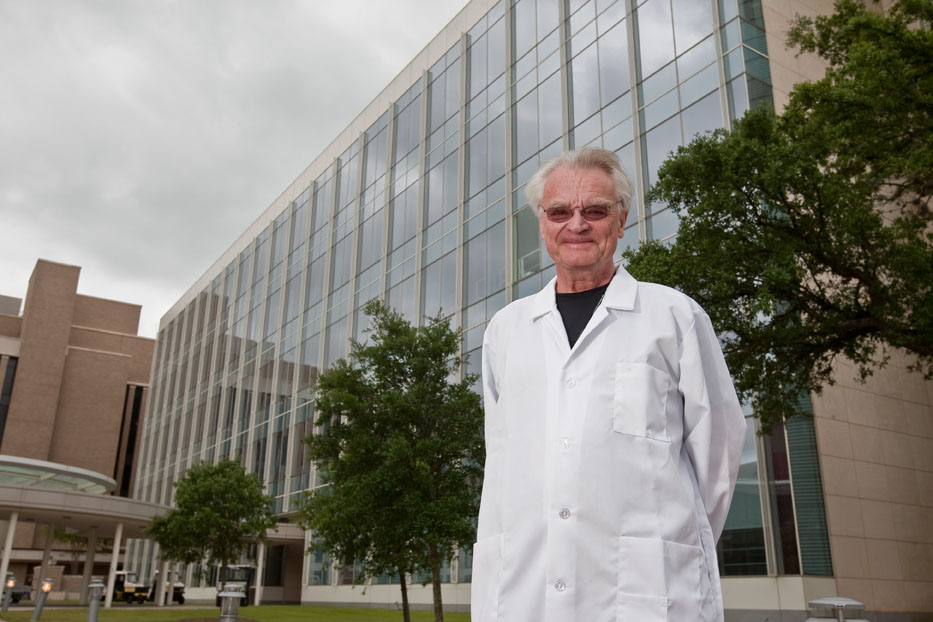Researchers at the University of Houston (UH) are recommending a new strategy for developing drugs to treat cancer, multiple sclerosis, Alzheimer’s and cardiovascular diseases.
In an invited review published in the October issue of Nature Reviews Drug Discovery, scientists at the Center for Nuclear Receptors and Cell Signaling (CNRCS) at UH outline the results of years of research following the team’s 1996 discovery of the estrogen receptor beta (ERβ).
“We have known for some time that female sex hormones – estrogens – influence a number of functions in the human body,” said Dr. Jan-Åke Gustafsson, UH professor and CNRCS director. “Only recently have we and others found that one of the estrogen receptors – ERβ – is a potential target for the treatment of Alzheimer’s and other chronic diseases.”
Gustafsson
is best known as a leading expert on estrogen receptors, being credited with
the earlier discovery of ERβ during his tenure at the Karolinska Institutet in
Stockholm, Sweden. In Houston since 2009, Gustafsson has hand-selected a team
of experts to build on his initial breakthrough. For this latest review, the
team was invited to share the most recent results of their research.
The two estrogen receptors, estrogen receptor alpha (ERα) and ERβ, have their effects on cells via activation by hormones circulating in the body. The influence of these receptors in the human body spans such diverse functions as fertility, metabolism, and the cardiovascular and nervous systems. Due to their expanded role in human health, these receptors represent an ideal target for drugs and therapeutic treatments.
Studies conducted following Gustafsson’s discovery of ERβ have shown intriguing differences in tissue distribution and gene regulation when compared to the role of ERα. There has since been an intense effort in both academia and industry to develop ERβ-specific research tools and potential therapeutics for a multitude of conditions.
One successful example of using ERβ as a drug target has proven the receptor as an effective cancer cell combatant in breast cancer tissue. Closer examination of human breast cancer cell lines determined that, while ERα alone may stimulate the development of tumors, the combined presence of ERα and ERβ reduced and prevented tumor development.
“These modulators are well-established in the treatment of breast cancer and osteoporosis,” Gustafsson said. “We now are pushing the limits of their influence to develop new treatments and ultimately save lives.”
CNRCS researchers continue to examine the two estrogen receptor subtypes in various animal disease models, focused on identifying therapeutic opportunities. ERβ remains the most likely target for expanding treatments beyond breast cancer. The widespread involvement of ERβ presents the greatest probability for impacting these other diseases. Early results indicate that the selective activation of ERβ may represent a safe, disease-modifying therapy for the treatment of Alzheimer’s disease.
Collaborators included Konrad F. Koehler and Stefan Nilsson of Karo Bio, a pharmaceutical company in Sweden. Gustafsson’s research is funded by the Texas Emerging Technology Fund, the Robert A. Welch Foundation and the Cancer Prevention and Research Institute of Texas. An abstract is available online at http://www.nature.com/nrd/journal/v10/n10/abs/nrd3551.html, and the review is highlighted in the journal’s “Patent Watch” column at http://www.nature.com/nrd/journal/v10/n10/full/nrd3574.html#Oestrogen-receptor-modulators.
###
Editorial Note: High-resolution photos of Jan-Åke Gustafsson are available to media by contacting Lisa Merkl.
About the University of Houston
The
University of Houston is a Carnegie-designated Tier One public research
university recognized by The Princeton Review as one of the nation’s best
colleges for undergraduate education. UH serves the globally competitive
Houston and Gulf Coast Region by providing world-class faculty, experiential
learning and strategic industry partnerships. Located in the nation’s
fourth-largest city, UH serves more than 38,500 students in the most ethnically
and culturally diverse region in the country.
About the
College of Natural Sciences and Mathematics
The UH College of Natural Sciences and
Mathematics, with 181 ranked faculty and approximately 4,500 students, offers
bachelor’s, master’s and doctoral degrees in the natural sciences,
computational sciences and mathematics.
Faculty members in the departments of biology and biochemistry,
chemistry, computer science, earth and atmospheric sciences, mathematics and
physics conduct internationally recognized research in collaboration with
industry, Texas Medical Center institutions, NASA and others worldwide.
About the UH Center for Nuclear
Receptors and Cell Signaling
Established
in 2009, the University of Houston Center for Nuclear Receptors and Cell
Signaling (CNRCS) is the centerpiece of the university’s tier-one biomedical
research initiative and member of the internationally renowned Texas Medical
Center. Working from the center’s state-of-the-art labs, CNRCS researchers
combine interdisciplinary research with dynamic collaboration within the
medical center and with industry partners, with the goal of finding new
treatments for an array of significant diseases, including cancer, diabetes and
metabolic syndrome. To learn more, visit http://cnrcs.uh.edu.
For more information about UH, visit the university’s Newsroom.
To receive UH science news via e-mail, sign up for UH-SciNews.
For additional news alerts about UH, follow us on Facebook and Twitter.
